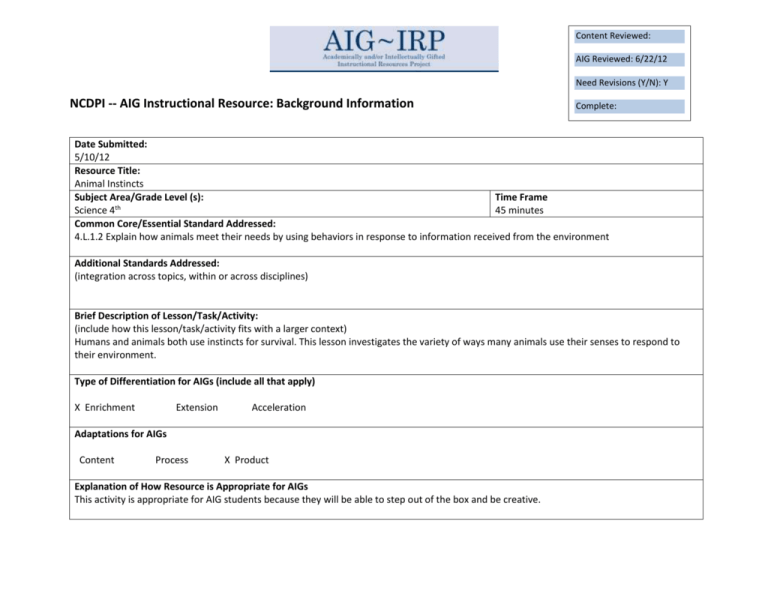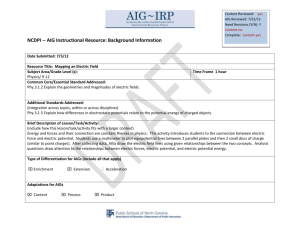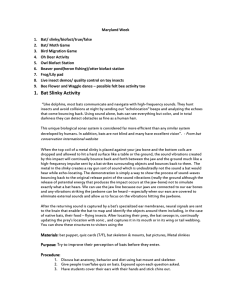NCDPI -- AIG Instructional Resource: Background Information
advertisement

Content Reviewed: AIG Reviewed: 6/22/12 Need Revisions (Y/N): Y NCDPI -- AIG Instructional Resource: Background Information Complete: Date Submitted: 5/10/12 Resource Title: Animal Instincts Subject Area/Grade Level (s): Time Frame th Science 4 45 minutes Common Core/Essential Standard Addressed: 4.L.1.2 Explain how animals meet their needs by using behaviors in response to information received from the environment Additional Standards Addressed: (integration across topics, within or across disciplines) Brief Description of Lesson/Task/Activity: (include how this lesson/task/activity fits with a larger context) Humans and animals both use instincts for survival. This lesson investigates the variety of ways many animals use their senses to respond to their environment. Type of Differentiation for AIGs (include all that apply) X Enrichment Extension Acceleration Adaptations for AIGs Content Process X Product Explanation of How Resource is Appropriate for AIGs This activity is appropriate for AIG students because they will be able to step out of the box and be creative. Needed Resources/Materials Pictures of a deer, an owl, a bat, a barracuda, and a catfish (available on PowerPoint attachment) Blank Sheet or template Pictures and Information on eight other animals Sources (all sources must be cited) Science Encyclopedia. 2004. TEACHER NOTES NCDPI AIG Curriculum Resource Outline Describe processes, steps, and materials needed at each stage of the lesson/activity. STAGE ONE: Engage • Hook • Prior knowledge • Instructional input • Modeling Description: Ask students to name the five senses. (hear, smell, taste, touch, sight). Use guiding questions if necessary. Ask, “How do humans use these senses in their everyday life?” Accept reasonable responses. Ask students, “How do humans use their senses to protect themselves in their environment? What might happen if we couldn’t use our senses?” STAGE TWO: ELABORATE • Guided and independent practice • Guiding questions Description: Ask, “What senses do animals have? How do you think animals use their senses in their environments?” Show the picture of the owl. Explain that owls are nocturnal or night time creatures. What senses does the owl need to survive at night? The owl needs large eyes and acute hearing to find prey. Show the picture of the bat. Explain that bats cannot see in total darkness so they use their keen sense of hearing. They use echolocation to find their way around. They send out sound waves to locate their prey. If the sound comes back to the bat’s ears, what do you think most likely is happening? Show the picture of the deer. Explain that deer have a great sense of smell. They smell the air for predators. They face the wind when they rest or eat. Ask, “How does facing the wind assist deer in their survival?” Show the picture of the barracuda. Explain that they use touch. Moving animals make ripples in the water. The barracuda has a lateral line that senses the movement. How does the function of the lateral line aide in survival? Show the picture of the catfish. The catfish is called the living tongue. What can you infer from its nickname? Explain that the catfish has taste buds over most of his body. STAGE THREE: EVALUATE • Assessment Description: Student will create a super animal. They will choose two distinct animals. These animals will be combined into one. The goal is to create an animal with unique behaviors and describe the type of environment it would have the best chance of survival in. They will create an environment for their animals. They will draw and write about their new animal’s habitat. Scale of 1-5 ___ Student demonstrated content knowledge when writing about the animal. Writing clearly states the animal’s habitat and behaviors. ___ Student’s drawing exhibit understanding of how the animal would appear. Drawing clearly notes habitat. TEACHER NOTES: A PowerPoint is attached that has photos of the deer, owl, bat, barracuda, and catfish for reference.







